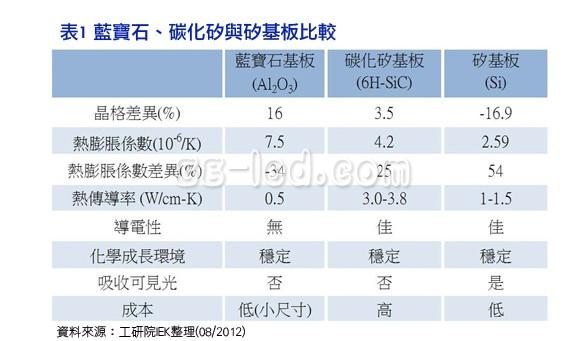The LED substrate market is about to change color. The silicon substrate LED chip of Toshiba and Bridgelux is expected to be mass-produced in October. Once the product is successfully launched, it will compress the living space of the mainstream sapphire substrate in the current LED market with higher cost performance. Related suppliers set off more intense price competition.
In order to make the price of LED components more competitive, the development of LED substrates has become an established trend. In addition to the current mainstream sapphire (Al203) substrate, Japanese semiconductor giant Toshiba and Bridgelux cooperated with 8-inch GaN on Silicon LED chip technology. One of the large size substrate materials.
Toshiba has announced that the silicon substrate will be put into production in October this year. The time course is the same as the industry's originally expected time point in 2013, a full season ahead; if mass production is successful, it is estimated that it can reduce the cost by 75% and become the most competitive price. White LED component. At that time, the "low price" advantage of large-size sapphire substrates will no longer exist.
Large size development is the key to LED substrate competition
The choice of LED epitaxial substrate material will affect the subsequent epitaxial quality. Therefore, different material substrates must be selected in view of the different crystal structures of different luminescent layer materials. Generally, the substrate is selected in the industry to consider the following factors, including high crystal structure of the wafer material, good electrical and thermal conductivity, easy processing, high stability and low cost in the wafer growth environment.
Among a number of influencing conditions, whether the "Lattice Constant" and "Thermal Expansion Coefficient" of the substrate can be well matched with the epitaxially grown film is an important factor affecting the yield of the product; Whether it is to develop in large size and mass production is the focus of competitiveness when products are commercialized.
Sapphire substrate is the mainstream
At present, the most commonly used substrate for epitaxial growth of nitride series is sapphire substrate; although it does not match the lattice constant and thermal expansion coefficient of GaN, there are 16% and 34% difference respectively (Table 1), but the sapphire in hardness It is better than silicon (Sic) substrate, and it has the characteristics of transparency and high temperature stability, and is suitable for the epitaxial growth of nitride. Compared with other substrates, it is currently 2 inches in the mainstream size of blue/green LEDs. The inch and 4 inch sapphire substrates are calculated at a much cheaper price and are currently in the mainstream.
Silicon carbide substrate price competitiveness is weak
In addition to sapphire substrates, LED supplier Cree uses silicon carbide (6H-SiC) substrates to grow nitride materials. The biggest advantage of silicon nitride substrate is the conductive property, and the lattice constant is only 3.5% mismatch with nitridation (Table 1). The positive and negative electrodes of the chip can be used on different sides to effectively reduce the chip size. Solve the problem of current crowding; however, silicon carbide substrates are very expensive and cost-incompetent.

In order to make the price of LED components more competitive, the development of LED substrates has become an established trend. In addition to the current mainstream sapphire (Al203) substrate, Japanese semiconductor giant Toshiba and Bridgelux cooperated with 8-inch GaN on Silicon LED chip technology. One of the large size substrate materials.
Toshiba has announced that the silicon substrate will be put into production in October this year. The time course is the same as the industry's originally expected time point in 2013, a full season ahead; if mass production is successful, it is estimated that it can reduce the cost by 75% and become the most competitive price. White LED component. At that time, the "low price" advantage of large-size sapphire substrates will no longer exist.
Large size development is the key to LED substrate competition
The choice of LED epitaxial substrate material will affect the subsequent epitaxial quality. Therefore, different material substrates must be selected in view of the different crystal structures of different luminescent layer materials. Generally, the substrate is selected in the industry to consider the following factors, including high crystal structure of the wafer material, good electrical and thermal conductivity, easy processing, high stability and low cost in the wafer growth environment.
Among a number of influencing conditions, whether the "Lattice Constant" and "Thermal Expansion Coefficient" of the substrate can be well matched with the epitaxially grown film is an important factor affecting the yield of the product; Whether it is to develop in large size and mass production is the focus of competitiveness when products are commercialized.
Sapphire substrate is the mainstream
At present, the most commonly used substrate for epitaxial growth of nitride series is sapphire substrate; although it does not match the lattice constant and thermal expansion coefficient of GaN, there are 16% and 34% difference respectively (Table 1), but the sapphire in hardness It is better than silicon (Sic) substrate, and it has the characteristics of transparency and high temperature stability, and is suitable for the epitaxial growth of nitride. Compared with other substrates, it is currently 2 inches in the mainstream size of blue/green LEDs. The inch and 4 inch sapphire substrates are calculated at a much cheaper price and are currently in the mainstream.
Silicon carbide substrate price competitiveness is weak
In addition to sapphire substrates, LED supplier Cree uses silicon carbide (6H-SiC) substrates to grow nitride materials. The biggest advantage of silicon nitride substrate is the conductive property, and the lattice constant is only 3.5% mismatch with nitridation (Table 1). The positive and negative electrodes of the chip can be used on different sides to effectively reduce the chip size. Solve the problem of current crowding; however, silicon carbide substrates are very expensive and cost-incompetent.


Flum Vape
Shenzhen Uscool Technology Co., Ltd , https://www.uscoolvape.com
![<?echo $_SERVER['SERVER_NAME'];?>](/template/twentyseventeen/skin/images/header.jpg)